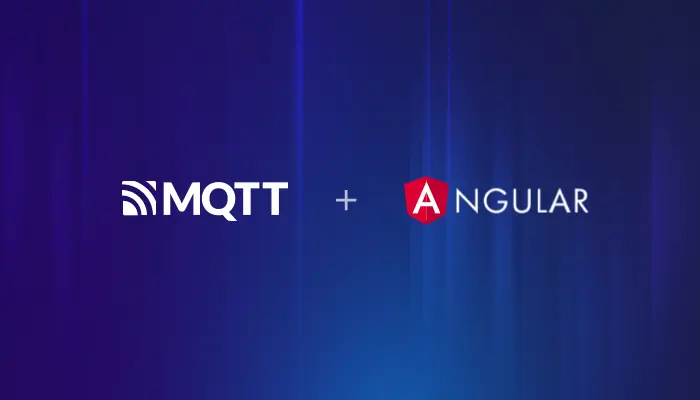How to Use MQTT in the Angular Projects

Table of Contents
Introduction
Angular is a development platform built on TypeScript. It features a component-based framework designed for creating scalable web applications, along with a comprehensive set of integrated libraries that cover routing, form management, client-server communication, and other essential functions. Additionally, Angular provides development tools to assist users in developing, building, testing, and updating code.
MQTT is a lightweight message transfer protocol for the Internet of Things (IoT), based on a publish/subscribe model. It enables one-to-many message distribution and application decoupling while minimizing transmission costs, thereby reducing network traffic. MQTT also accommodates various delivery requirements through its three Quality of Service (QoS) levels for messages.
This article will explain how to implement the MQTT protocol in Angular projects, covering how to connect, subscribe, send and receive messages, unsubscribe, and perform other functions between clients and the MQTT Broker.
Setting Up Your Angular Project with MQTT
Create a New Project
You can refer to two different documentation sources:
- Create an Angular project with the Angular CLI - This is the archived documentation for Angular v17
- angular.dev - This is the current version of Angular documentation
Install the Angular CLI:
npm install -g @angular/cli
Create a new workspace and initial application:
ng new my-app
Navigate to the project directory:
cd my-app
Now you're ready to start development!
Install the MQTT Client Library
The library used in this case is ngx-mqtt, which isn’t just a wrapper around MQTT.js for angular >= 2. It uses observables for efficient subscription handling and message routing, making it ideal for Angular applications.
Install it using npm or yarn command:
npm install ngx-mqtt --save
yarn add ngx-mqtt
Implementing MQTT in Angular
Connecting to an MQTT Broker
We use the free public MQTT Broker provided by EMQX in this article, which is built on the EMQX MQTT Platform. EMQX is a large-scale distributed IoT MQTT message broker that can efficiently and reliably connect massive IoT devices, process and distribute messages and event flow data in real-time, and help customers build business-critical IoT platforms and applications.
The server access information is as follows:
- Broker:
broker.emqx.io - TCP Port: 1883
- WebSocket Port: 8083
Key codes for connection:
import type { IMqttServiceOptions, MqttService } from 'ngx-mqtt'
import type { Subscription } from 'rxjs'
import { IClientSubscribeOptions } from 'mqtt-browser'
import { IMqttMessage, IPublishOptions } from 'ngx-mqtt'
@Component({
selector: 'app-root',
templateUrl: './app.component.html',
styleUrls: ['./app.component.scss'],
})
export class AppComponent {
constructor(private _mqttService: MqttService) {
this.client = this._mqttService
}
private curSubscription: Subscription | undefined
connection = {
hostname: 'broker.emqx.io',
port: 8083,
path: '/mqtt',
clean: true, // Retain session
connectTimeout: 4000, // Timeout period
reconnectPeriod: 4000, // Reconnect period
// Authentication information
clientId: 'mqttx_597046f4',
username: 'emqx_test',
password: 'emqx_test',
protocol: 'ws',
}
subscription = {
topic: 'topic/mqttx',
qos: 0,
}
publish = {
topic: 'topic/browser',
qos: 0,
payload: '{ "msg": "Hello, I am browser." }',
}
receiveNews = ''
qosList = [
{ label: 0, value: 0 },
{ label: 1, value: 1 },
{ label: 2, value: 2 },
]
client: MqttService | undefined
isConnection = false
subscribeSuccess = false
// Create a connection
createConnection() {
// Connection string, which allows the protocol to specify the connection method to be used
// ws Unencrypted WebSocket connection
// wss Encrypted WebSocket connection
// mqtt Unencrypted TCP connection
// mqtts Encrypted TCP connection
try {
this.client?.connect(this.connection as IMqttServiceOptions)
} catch (error) {
console.log('mqtt.connect error', error)
}
this.client?.onConnect.subscribe(() => {
this.isConnection = true
console.log('Connection succeeded!')
})
this.client?.onError.subscribe((error: any) => {
this.isConnection = false
console.log('Connection failed', error)
})
this.client?.onMessage.subscribe((packet: any) => {
this.receiveNews = this.receiveNews.concat(packet.payload.toString())
console.log(`Received message ${packet.payload.toString()} from topic ${packet.topic}`)
})
}
}
Subscribing to Topics
Upon connecting to the MQTT Broker successfully, call the subscribe method of the current MQTT instance and pass in the Topic and QoS parameters for the successful subscription.
doSubscribe() {
const { topic, qos } = this.subscription
this.curSubscription = this.client?.observe(topic, { qos } as IClientSubscribeOptions).subscribe((message: IMqttMessage) => {
this.subscribeSuccess = true
console.log('Subscribe to topics res', message.payload.toString())
})
}
Unsubscribing from Topics
The unsubscribe method can release the resources held by the subscription.
doUnSubscribe() {
this.curSubscription?.unsubscribe()
this.subscribeSuccess = false
}
Publishing Messages
The usafePublish publishes messages on topics with optional options, such as QoS and Retain, as shown below.
doPublish() {
const { topic, qos, payload } = this.publish
console.log(this.publish)
this.client?.unsafePublish(topic, payload, { qos } as IPublishOptions)
}
Disconnecting from MQTT Broker
The disconnect will disconnect the MQTT client. The parameter true is passed in to force a disconnection from the MQTT client.
destroyConnection() {
try {
this.client?.disconnect(true)
this.isConnection = false
console.log('Successfully disconnected!')
} catch (error: any) {
console.log('Disconnect failed', error.toString())
}
}
Testing the Angular MQTT Application
We create the following simple browser application with Angular, which has the following functions: Establish a connection, Subscribe to topics, Send & receive messages, Unsubscribe, Disconnect, and so on.
Code Examples Reference
For Angular v17 and above code example, see: Angular v17 MQTT Example
For previous Angular versions code example, see: Angular MQTT Example

Use MQTT 5.0 client tool - MQTTX as another client to test message sending & receiving.

Before MQTTX sends a second message, unsubscribe at the browser side, and the browser side will not receive subsequent messages sent by MQTTX.
Summary
This guide illustrated how to integrate MQTT into an Angular application, enabling functions like connecting to an MQTT Broker, subscribing to topics, and publishing messages. Combining Angular with MQTT opens up exciting possibilities, such as developing real-time monitoring systems for IoT devices or chat systems for customer service.
